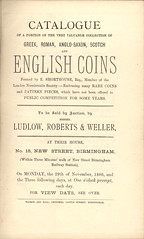
PREV ARTICLE
NEXT ARTICLE
FULL ISSUE
PREV FULL ISSUE
MORE ON AMERICAN COINS IN THE SHORTHOUSE COLLECTION
Regarding the sale discussed earlier by Paul Withers and Dave Hirt,
George Kolbe forwarded this description of a lot (#367) sold in the 1997 Kolbe/Spink Sale for $325 hammer. Thanks!
-Editor
This obscure and seldom-offered sale features E. Shorthouse's famous comments "To American Coin Collectors." Manville & Robertson term the catalogue "amusing" and the man "contentious." After a lengthy description of a Queen Anne BELLO • ET• PACE pattern farthing in copper, the catalogue notes: "Unless a starting bid of £15 is made, this lot will be withdrawn, on the ground, that if an important English coin of which only three are known is not worth £15, it is worth nothing." According to Manville & Robertson, the coin brought £19.7.6 but they also note that "Dealers Spink, Thomas, and Verity, bought-in more than a third of the lots. These were offered in London the next year and some again in 1888." In the Appendix, Shorthouse apologizes for the "prejudicial statement (lot 228) that the youthful Emperor Julian II. had a ‘Young Bear Head," noting that "‘Young' as distinguished from…‘mature'…and ‘Bare' head as distinguished from ‘laureated' was all that was intended." The sale featured relatively few lots of American interest, mostly colonial coins sold in lots. Shorthouse's interest in the field, however, was intense and his lengthy comments "To American Coin Collectors" are filled with fascinating observations. He offers a reward for information leading to the return of "a valuable set of ‘Lord Baltimore' silver money, consisting of the Shilling, Sixpence, and rare Groat, in unusually fine condition," promising the informant "a P.O. order for £5, also a beautiful U.S. 1796 cent, with the cap, in absolutely Mint condition, for his trouble." He then recounts the experiences of "Three Years' American Coin Collecting in England." "As late as 1882 U.S. coins were to be picked up in England very cheaply, now they very seldom occur. Our ignorance of them was, and still is, in most cases, profound." He notes that "A lovely 1794 dollar stood for two years in the ‘Bureau de Change' window, Charing Cross Station, London, staring at the British public; the writer could have had it a dozen times at £1. Finally swept off by good Mr. Randall on his last visit to the British Isles." Though not cited in the bibliography, this text is doubtless the source of the pedigree in Breen's Encyclopedia of the Nova Constellatio 100 bit to "T. F. Cloud, Pawnbroker, 207 High Holborn, London." Shorthouse acquired the unique pattern for two shillings, three pence. "Knowing about as much about it as the average Christian knows about the Origin of Evil, he forwarded it to his friend Mr. W. Elliot Woodward…with whom an English gentleman can deal with safety and pleasure." Originally offered in the Addenda to Woodward's 1885 73rd sale with a $550 reserve, it finally sold for $272 in the 1886 83rd sale. Woodward's account of the unique pattern is at variance with Shorthouse ("It has existed for an unknown period in the collection of an old numismatist in Scotland, whose recent death led to the dispersion of his cabinet by auction."). Shorthouse goes on to recount with pride the acquisition of a number of other "Plums," including" "An ‘Ameri" cent., in mint condition, another fine; a 1795 cent., thick lettered edge, in absolutely uncirculated condition…a 1796, with cap, in equal condition, resembles a proof…two fine 1804 cents…a 1799 cent. in mint state was just missed at 7s. 6d.…Baltimore money (not yet stolen); rows of ‘pine' and ‘oak tree' money, some very fine;" etc. He notes "In Conclusion" that "American coins, compared with those of other nations, appear to the writer to be unquestionably the most uninteresting series in the world." Then he suggests "that some American gentleman, wishing to acquire a very fine U. S. collection, had better come over next summer (1887)…and take away the collection to that Great and Amazing Country…to which it properly belongs…"
To read the earlier E-Sylum article, see:
MORE ON AMERICAN COINS IN THE SHORTHOUSE COLLECTION
(www.coinbooks.org/esylum_v14n24a23.html)
The Numismatic Bibliomania Society is a non-profit organization promoting numismatic literature. See our web site at coinbooks.org. To submit items for publication in The E-Sylum, write to the Editor at this address: whomren@gmail.com To subscribe go to: https://my.binhost.com/lists/listinfo/esylum All Rights Reserved. NBS Home Page Contact the NBS webmaster 
|
